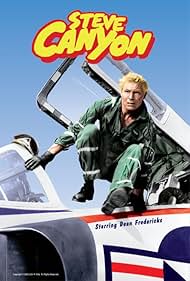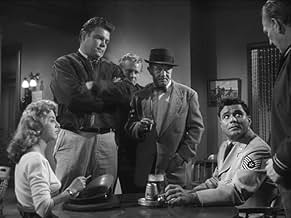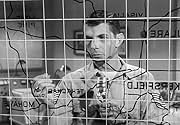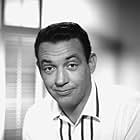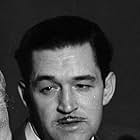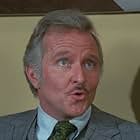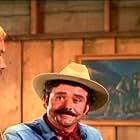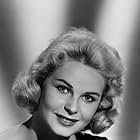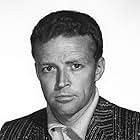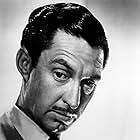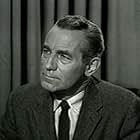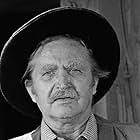Air Force pilot Steve Canyon, the commander of Big Thunder Air Force Base, travels from base to base as an all-around trouble-shooter, when he's not dealing with the the personal and militar... Read allAir Force pilot Steve Canyon, the commander of Big Thunder Air Force Base, travels from base to base as an all-around trouble-shooter, when he's not dealing with the the personal and military problems of his own everyday life.Air Force pilot Steve Canyon, the commander of Big Thunder Air Force Base, travels from base to base as an all-around trouble-shooter, when he's not dealing with the the personal and military problems of his own everyday life.
Browse episodes
Storyline
Did you know
- TriviaThe jet fighter seen in the opening credits is an F-102 Delta Dagger, with the lettering "Lt. Col Steve Canyon USAF" on the nose when seen in close-up.
- GoofsCanyon's orders are from the Air Force, Washington 25, DC (now zip code 20025). There is no such postal zone and Headquarters US Air Force is located in Arlington, VA.
- ConnectionsReferenced in Biography: Mary Tyler Moore: All American-Girl (1995)
Featured review
Having a successful comic adapted to the Radio, Television or the Movies is a great feat and a real feather in a Cartoonist's cap; as well as causing a corresponding bulge in his Wallet and Bank Account. But, just imagine a cartoonist's creating two highly successful and highly merchandised strips! It's like catching lightening in a bottle, with all of its perks, except that it's doubled! After having some successes with a single panel humor feature, in 1933, Milton Canniff came up with a kiddie adventure trip titled, "DICKIE DARE". He got plenty of notice and he got the assignment to come up with an Adventure Comic Strip featuring a kid and his grown man mentor. What Mr. Canniff created was "TERRY AND THE PIRATES", an adventure with continuing story lines. His employer, The Chicago Tribune-NY News Syndicate, retained the rights, but Milton was the regular artist on it and continued in that capacity until 1947, when he parted company with the Tribune organization.
In the 13 or so years that had elapsed ever since Terry's debut, the Strip ha proved to be extremely popular, spawning a host of Merchandising in the likes of Toys, Coloring Books, Big Little Books and the like. There was also a daily TERRY AND THE PIRATES on the Radio.
In 1940, Columbia Pictures purchased the screen rights and came out with TERRY AND THE PIRATES as a 15 Chapter, Cliff-Hanger Movie Serial. The serial starred a bleach-blond William Tracy as young Terry Lee, with Granville Owen (Jeff York) as his mentor, A dozen years later, it was Television that was the reigning King and the DuMont Television Network presented the ½ hour long series of "TERRY AND THE PIRATES" (Don Sharpe Prod. /Douglas Fairbanks, Jr. Prod., 1952-53). This featured a now grown-up Terry (John Baer) and his sidekick, Charles C. Charles aka "Hot Shot Charlie" (William Tracy*). They worked for an Airline in China named Air Cathay. (But that's another story!).
As for STEVE CANYON, the strip was highly successful for Mr. Canniff. It probably had a more true to life set of story lines (aka "continuities" in the Newspaper Trade), which were also more appealing to the older readers, affectionately known as "Adults." Another plus that Canniff had with his new airborne hero was it was just about this time in 1947 that the United States Air Force was born. Having started its gestation period as the Army Air Corps, then the Army Air Force; it became a completely independent branch of the U.S.Armed Forces.
As for the TV Series, it did all right as far as it went with the adaptation. It featured the Star, Dean Fredericks, sporting the peroxide treatment on the hair, but retaining the black eyebrows, just like Steve in the Sunday Color Comics (but now in our Chicago Sun-Times, rather than Mr. Canniff's former stompin' grounds over at the Chicago Tribune.) Otherwise, the late Mr. Fredericks had a trim, solid athletic look about him and looked that he was ready for whatever the trouble was that particular Saturday evening. (on NBC, 8:00 P.M., EST.
The individual episodes were just that, complete stories in themselves. There were no continued stories ("continuities", if you please!) in the series. The opening would show Steve piloting his Sabre Jet through "the Wild Blue Yonder", all decked-out with his helmet, flying suit and full face oxygen mask with goggles. As we hear the very good original theme, composed by "DRAGNET" composer, Walter Schumann; we hear the voice-over narrator (Paul Frees, I think!) reciting the narrative of the orders that Steve was to follow this week. It always went something lika thisa: "15 OCT 1958. From Strategic Air Command, To: Canyon, Stevenson B., Lt. Colonel. Proceed at once to Chennault Air Force Base, Lake Charles, Louisiana concerning the matter of the recent rash of jet mal-functions, uh, ya ya ya ya ya .."
Steve was a sort of trouble shooter for the Air Force; you know, kinda like today's TV series JAG or NCIS; or maybe even a little like Bing Crosby's Fr. O'Malley in GOING MY WAY or THE BELLS OF ST. MARY'S.
In the 13 or so years that had elapsed ever since Terry's debut, the Strip ha proved to be extremely popular, spawning a host of Merchandising in the likes of Toys, Coloring Books, Big Little Books and the like. There was also a daily TERRY AND THE PIRATES on the Radio.
In 1940, Columbia Pictures purchased the screen rights and came out with TERRY AND THE PIRATES as a 15 Chapter, Cliff-Hanger Movie Serial. The serial starred a bleach-blond William Tracy as young Terry Lee, with Granville Owen (Jeff York) as his mentor, A dozen years later, it was Television that was the reigning King and the DuMont Television Network presented the ½ hour long series of "TERRY AND THE PIRATES" (Don Sharpe Prod. /Douglas Fairbanks, Jr. Prod., 1952-53). This featured a now grown-up Terry (John Baer) and his sidekick, Charles C. Charles aka "Hot Shot Charlie" (William Tracy*). They worked for an Airline in China named Air Cathay. (But that's another story!).
As for STEVE CANYON, the strip was highly successful for Mr. Canniff. It probably had a more true to life set of story lines (aka "continuities" in the Newspaper Trade), which were also more appealing to the older readers, affectionately known as "Adults." Another plus that Canniff had with his new airborne hero was it was just about this time in 1947 that the United States Air Force was born. Having started its gestation period as the Army Air Corps, then the Army Air Force; it became a completely independent branch of the U.S.Armed Forces.
As for the TV Series, it did all right as far as it went with the adaptation. It featured the Star, Dean Fredericks, sporting the peroxide treatment on the hair, but retaining the black eyebrows, just like Steve in the Sunday Color Comics (but now in our Chicago Sun-Times, rather than Mr. Canniff's former stompin' grounds over at the Chicago Tribune.) Otherwise, the late Mr. Fredericks had a trim, solid athletic look about him and looked that he was ready for whatever the trouble was that particular Saturday evening. (on NBC, 8:00 P.M., EST.
The individual episodes were just that, complete stories in themselves. There were no continued stories ("continuities", if you please!) in the series. The opening would show Steve piloting his Sabre Jet through "the Wild Blue Yonder", all decked-out with his helmet, flying suit and full face oxygen mask with goggles. As we hear the very good original theme, composed by "DRAGNET" composer, Walter Schumann; we hear the voice-over narrator (Paul Frees, I think!) reciting the narrative of the orders that Steve was to follow this week. It always went something lika thisa: "15 OCT 1958. From Strategic Air Command, To: Canyon, Stevenson B., Lt. Colonel. Proceed at once to Chennault Air Force Base, Lake Charles, Louisiana concerning the matter of the recent rash of jet mal-functions, uh, ya ya ya ya ya .."
Steve was a sort of trouble shooter for the Air Force; you know, kinda like today's TV series JAG or NCIS; or maybe even a little like Bing Crosby's Fr. O'Malley in GOING MY WAY or THE BELLS OF ST. MARY'S.
- How many seasons does Steve Canyon have?Powered by Alexa
Details
- Runtime30 minutes
- Color
- Aspect ratio
- 1.33 : 1
Contribute to this page
Suggest an edit or add missing content

